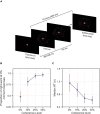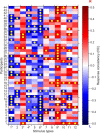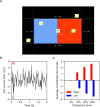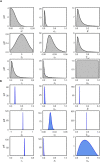Stochastic Motion Stimuli Influence Perceptual Choices in Human Participants
- PMID: 35309084
- PMCID: PMC8926215
- DOI: 10.3389/fnins.2021.749728
Stochastic Motion Stimuli Influence Perceptual Choices in Human Participants
Abstract
In the study of perceptual decision making, it has been widely assumed that random fluctuations of motion stimuli are irrelevant for a participant's choice. Recently, evidence was presented that these random fluctuations have a measurable effect on the relationship between neuronal and behavioral variability, the so-called choice probability. Here, we test, in a behavioral experiment, whether stochastic motion stimuli influence the choices of human participants. Our results show that for specific stochastic motion stimuli, participants indeed make biased choices, where the bias is consistent over participants. Using a computational model, we show that this consistent choice bias is caused by subtle motion information contained in the motion noise. We discuss the implications of this finding for future studies of perceptual decision making. Specifically, we suggest that future experiments should be complemented with a stimulus-informed modeling approach to control for the effects of apparent decision evidence in random stimuli.
Keywords: Bayesian inference; drift-diffusion model; model comparison; perceptual decision making; random-dot motion task.
Copyright © 2022 Fard, Bitzer, Pannasch and Kiebel.
Conflict of interest statement
The authors declare that the research was conducted in the absence of any commercial or financial relationships that could be construed as a potential conflict of interest.
Figures









Similar articles
-
Support for the Time-Varying Drift Rate Model of Perceptual Discrimination in Dynamic and Static Noise Using Bayesian Model-Fitting Methodology.Entropy (Basel). 2024 Jul 28;26(8):642. doi: 10.3390/e26080642. Entropy (Basel). 2024. PMID: 39202112 Free PMC article.
-
Stochastic resonance enhances the rate of evidence accumulation during combined brain stimulation and perceptual decision-making.PLoS Comput Biol. 2018 Jul 18;14(7):e1006301. doi: 10.1371/journal.pcbi.1006301. eCollection 2018 Jul. PLoS Comput Biol. 2018. PMID: 30020922 Free PMC article.
-
Adaptive History Biases Result from Confidence-Weighted Accumulation of past Choices.J Neurosci. 2018 Mar 7;38(10):2418-2429. doi: 10.1523/JNEUROSCI.2189-17.2017. Epub 2018 Jan 25. J Neurosci. 2018. PMID: 29371318 Free PMC article.
-
Neuronal signatures of a random-dot motion comparison task.Neuroimage. 2019 Jun;193:57-66. doi: 10.1016/j.neuroimage.2019.02.071. Epub 2019 Mar 5. Neuroimage. 2019. PMID: 30849531
-
Vision for the blind: visual psychophysics and blinded inference for decision models.Psychon Bull Rev. 2020 Oct;27(5):882-910. doi: 10.3758/s13423-020-01742-7. Psychon Bull Rev. 2020. PMID: 32514800 Free PMC article. Review.
References
-
- Barthelmé S., Chopin N. (2013). Expectation propagation for likelihood-free inference. J. Am. Stat. Assoc. 109 315–333. 10.1080/01621459.2013.864178 - DOI
-
- Benjamini Y., Hochberg Y. (1995). Controlling the false discovery rate – a practical and powerful approach to multiple testing. J. R. Stat. Soc. Ser. B Methodol. 57 289–300. 10.1111/j.2517-6161.1995.tb02031.x - DOI
LinkOut - more resources
Full Text Sources

